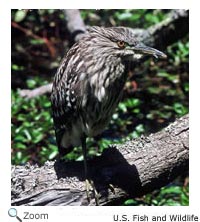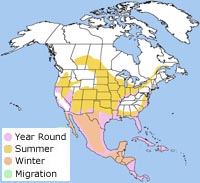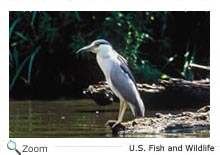Characteristics
 The black-crowned night heron is 23-28 inches tall. It has a wingspan of almost four feet. It is a medium-sized heron with a stocky body and short legs and neck. It has a black crown and back, gray wings and a white underside. The black-crowned night heron is 23-28 inches tall. It has a wingspan of almost four feet. It is a medium-sized heron with a stocky body and short legs and neck. It has a black crown and back, gray wings and a white underside.
 Adults have red eyes and yellow legs and feet. In breeding season adults have two long white plumes on their heads. Females and males look alike, but females are a little smaller. Immature night herons have a gray-brown head, chest, and belly streaked with white. Their eyes are yellow and they have gray legs. Black-crowned night herons don't have adult plumage until they are about three years old. Adults have red eyes and yellow legs and feet. In breeding season adults have two long white plumes on their heads. Females and males look alike, but females are a little smaller. Immature night herons have a gray-brown head, chest, and belly streaked with white. Their eyes are yellow and they have gray legs. Black-crowned night herons don't have adult plumage until they are about three years old.
Range
 The black-crowned night heron breeds from Washington; Saskatchewan, Canada; Minnesota; and New Brunswick, Canada south to southern South America. It is not found in the Rocky Mountain region. It winters in the southern United States. Migration happens in large flocks and almost always at night. The black-crowned night heron breeds from Washington; Saskatchewan, Canada; Minnesota; and New Brunswick, Canada south to southern South America. It is not found in the Rocky Mountain region. It winters in the southern United States. Migration happens in large flocks and almost always at night.
Habitat
The black-crowned night heron lives in fresh and saltwater marshes, swamps, lakes and wooded streams.
| |
|
Diet
 The black-crowned night heron hunts for food in the early morning hours and at dusk. It stands and waits for prey like frogs and fish to pass by and them snatches them up with its bill. It sometimes raids the nests of other herons and birds and steals the chicks. It also eats amphibians, crustaceans, insects and small mammals.
Life Cycle
The female black-crowned night heron lays three to five eggs in a nest in the reeds or thicket and occasionally in a tree. The nests are made of sticks and twigs. The chicks hatch in 24-26 days. Both parents incubate the eggs and feed the chicks regurgitated food. Black-crowned night herons nest in colonies and will often nest with other bird like ibises and other herons. The chicks will fledge in 42-49 days.
Behavior
Male night herons use their nests to attract a mate. The same nest may be used for many years.
|